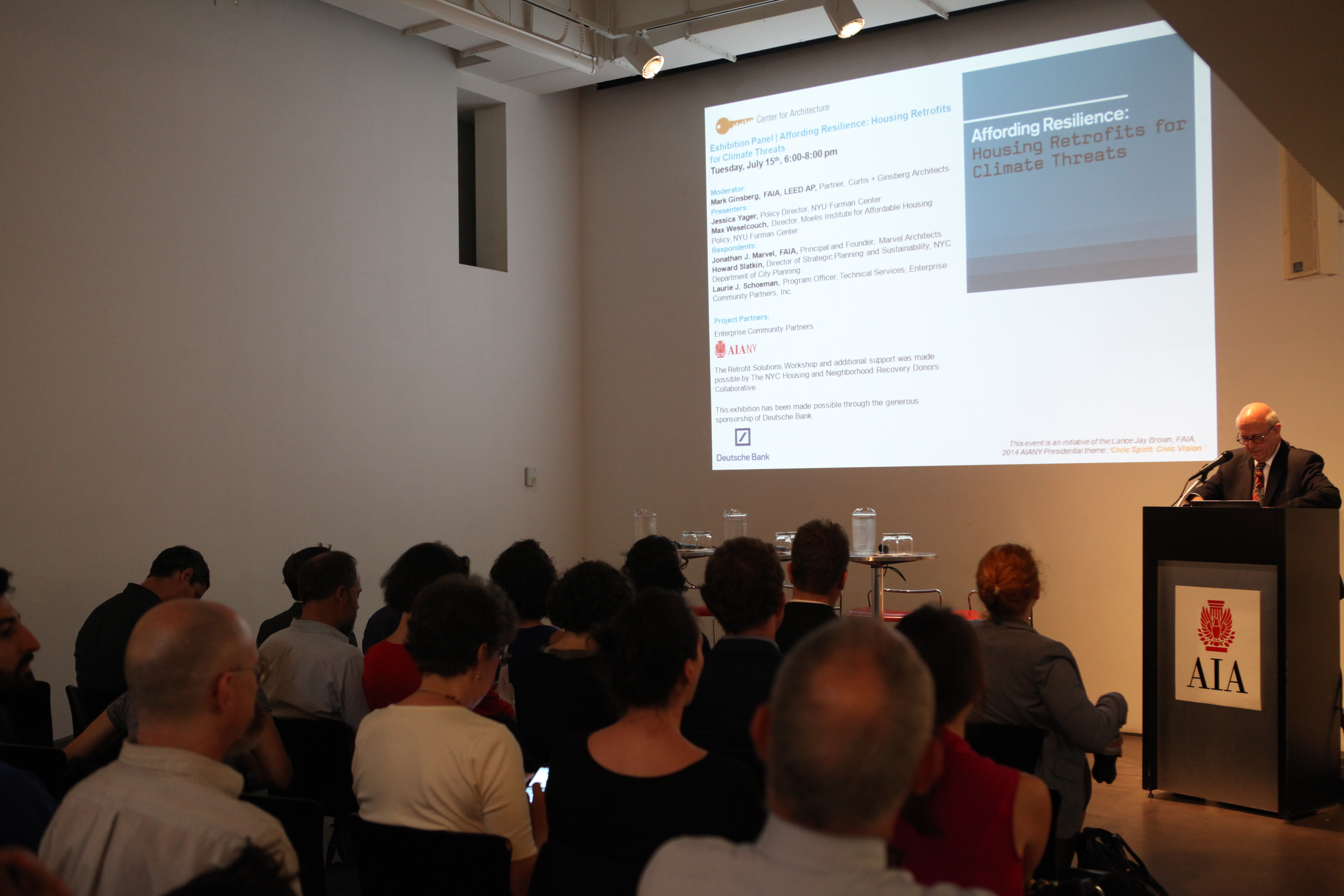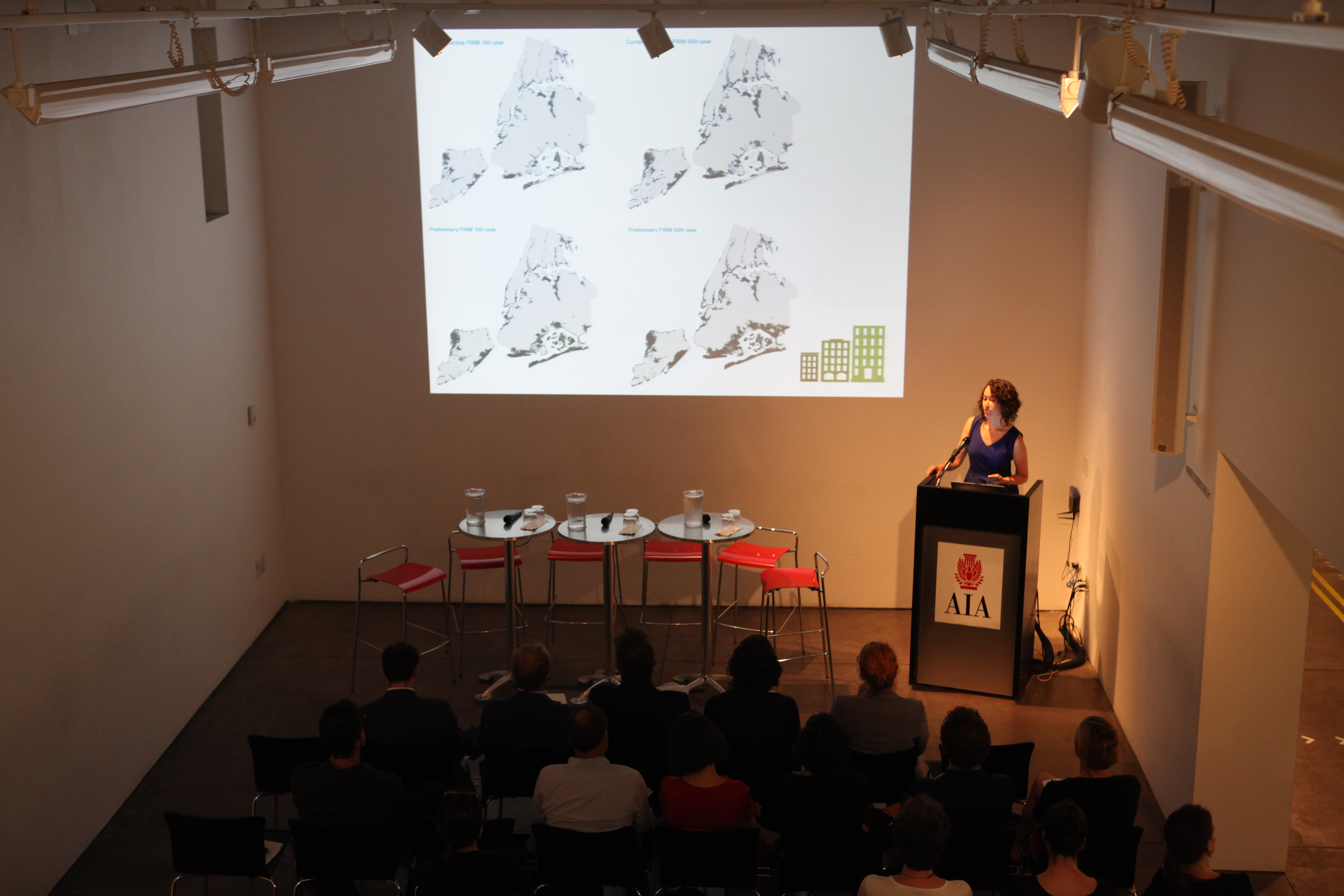by Bill Millard
As New York’s built environment evolves, resilience against climate-related challenges is a critical priority. Affordable housing is another. With much of the city’s housing stock standing in need of costly retrofitting against climatic threats, these values could be headed for a collision. If one important definition of tragedy (G.W.F. Hegel’s) is a clash between two legitimate and urgent but incompatible values, older multifamily buildings (particularly those located in the city’s 100-year floodplains) could be the site of an impending tragedy assuming several foreseeable forms, including loss of affordable units, inadequate stormproofing – and perhaps, for some of the city’s most vulnerable populations, accelerated displacement or worse.
NYU’s Furman Center, an urban-policy think tank jointly operated by the university’s law school and Wagner Graduate School of Public Service, has published The Price of Resilience: Can Multifamily Housing Afford to Adapt? – a report that examines the regulatory, financial, and social aspects of these converging challenges. On the eve of releasing the report, as an initiative of the 2014 AIANY Presidential Theme “Civic Spirit: Civic Vision” and coordinated with the “Affording Resilience” exhibition on view at the Center for Architecture until 08.07.14, representatives of the Furman Center discussed the report’s findings with two architects and two planners. There is no simple answer to the question its subtitle poses, beyond an unsettling “possibly not,” The current regulatory framework is unprepared for the problem, and private owners are caught between disincentives to upgrade their buildings and the likelihood of soaring flood-insurance costs if they do not. Recognizing the impending problem is a necessary first step toward heading it off, even if financially and politically feasible solutions are not in sight.
Furman Center data analyst Max Weselcouch presented the findings, outlining the challenges before the discussion with director Jessica Yager and other panelists. Only in 1983 did the city’s code require floodproofing in areas deemed vulnerable by the Federal Emergency Management Agency (FEMA); housing units and building mechanical systems are often located below base flood elevation (BFE); low-income citizens tend to live in floodplains. If retrofitting costs exceed 50% of a building’s value, Weselcouch pointed out, the retrofit is defined as “substantial improvements” and triggers a requirement for full code compliance, creating an incentive for owners to avoid retrofits altogether. “Flood insurance premiums may rise to unaffordable rates,” she noted, “but to lower the rates, building owners need to undertake expensive retrofits that they may not be able to afford while charging affordable rents. If they do nothing, they won’t be able to afford their flood insurance, but right now they can’t afford to do the retrofits.”
Part of the problem stems from the concentration on lower-density housing in the retrofitting guidelines issued by FEMA. One- to four-family buildings, the norm on which national standards are based, constitute only about a third of New York’s vulnerable residential buildings. A single-family house can be elevated on a foundation above BFE, an option not available to larger or attached buildings. FEMA’s new flood insurance maps locate nearly 5,000 larger urban multifamily buildings, comprising 170,000 housing units, in New York City’s 100-year floodplain. The majority of these units (some 80%) are rent-stabilized or receive affordable-housing subsidies, reducing landlords’ ability to pass along retrofitting costs through rent increases. Conversion of units from stabilized or subsidized status to market rates would presumably improve landlords’ incentives at the cost of worsening the city’s affordability problems. Eliminating units located below BFE, too, would deplete affordable housing stock.
The National Flood Insurance Program (NFIP) is phasing out subsidized premiums under the 2012 Biggert-Waters Flood Insurance Reform Act, so that insurance rates on noncompliant buildings will inevitably rise to “actuarially sound” levels, though the 2014 Homeowner Flood Insurance Affordability Act delays implementation of Biggert-Waters and limits premium increases to 18% annually until they reach the new rate. Climate change exacerbates the problem, Weselcouch added: “In the past 30 years or so, what we once thought was the 500-year floodplain has largely become the new 100-year floodplain.”
Recognizing the complexity of the problem, the Furman Center, AIANY, and Enterprise Community Partners convened a Retrofit Solutions Workshop last January. Part of this investigation, included in the new report, involved projecting detailed solutions and financial projections for three sample buildings: a small attached walkup on flood-exposed Baltic Street in Brooklyn, an attached elevator building in the East Village, and a tower-in-the-park on Coney Island. Options, respectively (along with relocating systems to the roof in all three buildings) include dry floodproofing, wet floodproofing plus addition of nonresidential uses to allow dry floodproofing of the cellar, and construction of demountable or permanent flood barriers. These case studies suggest that options exist for individual sites, though a more comprehensive policy solution remains a challenge.
An underlying concept of the NFIP, noted respondent Howard Slatkin of the NYC Department of City Planning (DCP) is that “buildings are disposable” after a relatively short lifespan. Most of New York’s housing stock, of course, has been built under opposite assumptions. The next congressional reauthorization of the program comes up in 2017, raising questions about whether the composition and competence of the legislative branch will change enough in three years to address this type of problem. Other potential sources of retrofit funding arising in the discussion included the New York State Energy Research and Development Authority (NYSERDA). But the scale of expenditures needed, Yager noted, may exceed state or city resources – and the private sector, if owners are allowed to raise rent rolls (perhaps creating a scenario in which the landlord lobby attempts to leverage the question of resilience into a strategic weapon against stabilization). FEMA grants for hazmat mitigation, observed Laurie Schoeman of Enterprise Community Partners, are available only after an emergency has been declared, limiting the utility of that funding stream in advance unless regulations change. The report does recommend certain municipal-level measures: pushing FEMA to develop guidelines for multifamily buildings and reduce premiums for partial mitigation; expanding the recent zoning changes beyond the 100-year floodplain; and reviewing its housing rehabilitation subsidy programs to ensure that emergency planning and resilience measures are financially sound. Whether these and further steps are feasible before the next Sandy-equivalent occurs is a different question.
Bill Millard is a freelance writer and editor whose work has appeared in Oculus, Icon, The Architect’s Newspaper, and other publications.
Event: Affording Resilience: Housing Retrofits for Climate Threats Panel
Location: Center for Architecture, 07.15.14
Speakers: Jessica Yager, Policy Director, NYU Furman Center; Max Weselcouch, Director, Moelis Institute for Affordable Housing Policy, NYU Furman Center; Respondents: Jonathan J. Marvel, FAIA, Principal and Founder, Marvel Architects; Howard Slatkin, Director of Strategic Planning and Sustainability, NYC Department of City Planning; Laurie J. Schoeman, Program Officer, Technical Services, Enterprise Community Partners, Inc.; Mark Ginsberg, FAIA, LEED AP, Partner, Curtis + Ginsberg Architects (moderator); Lance Jay Brown, FAIA, 2014 President, AIANY (introduction)
Sponsors: Deutsche Bank (exhibition sponsor); NYC Housing and Neighborhood Recovery Donors Collaborative: AIANY, Enterprise Community Partners (project partners)


